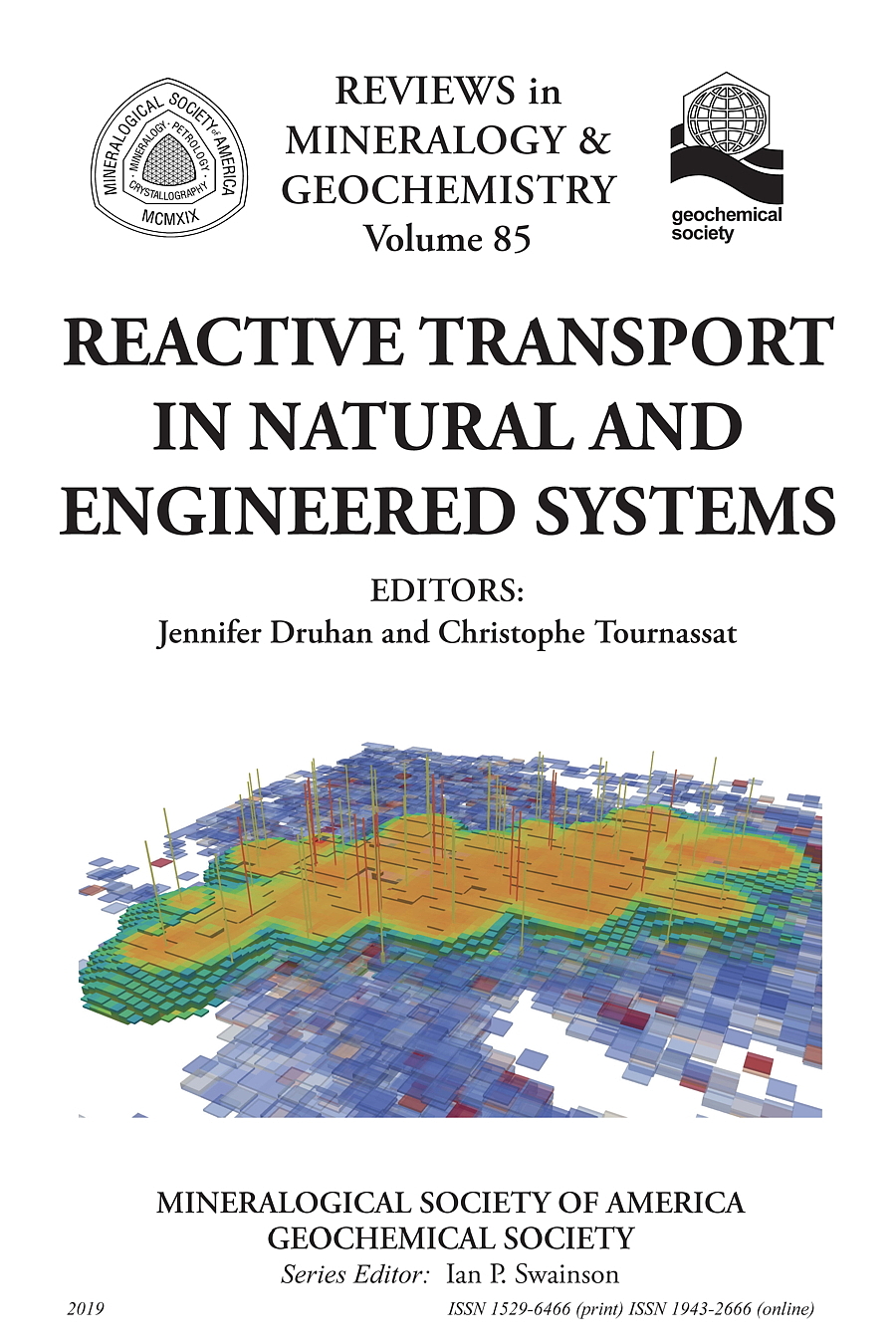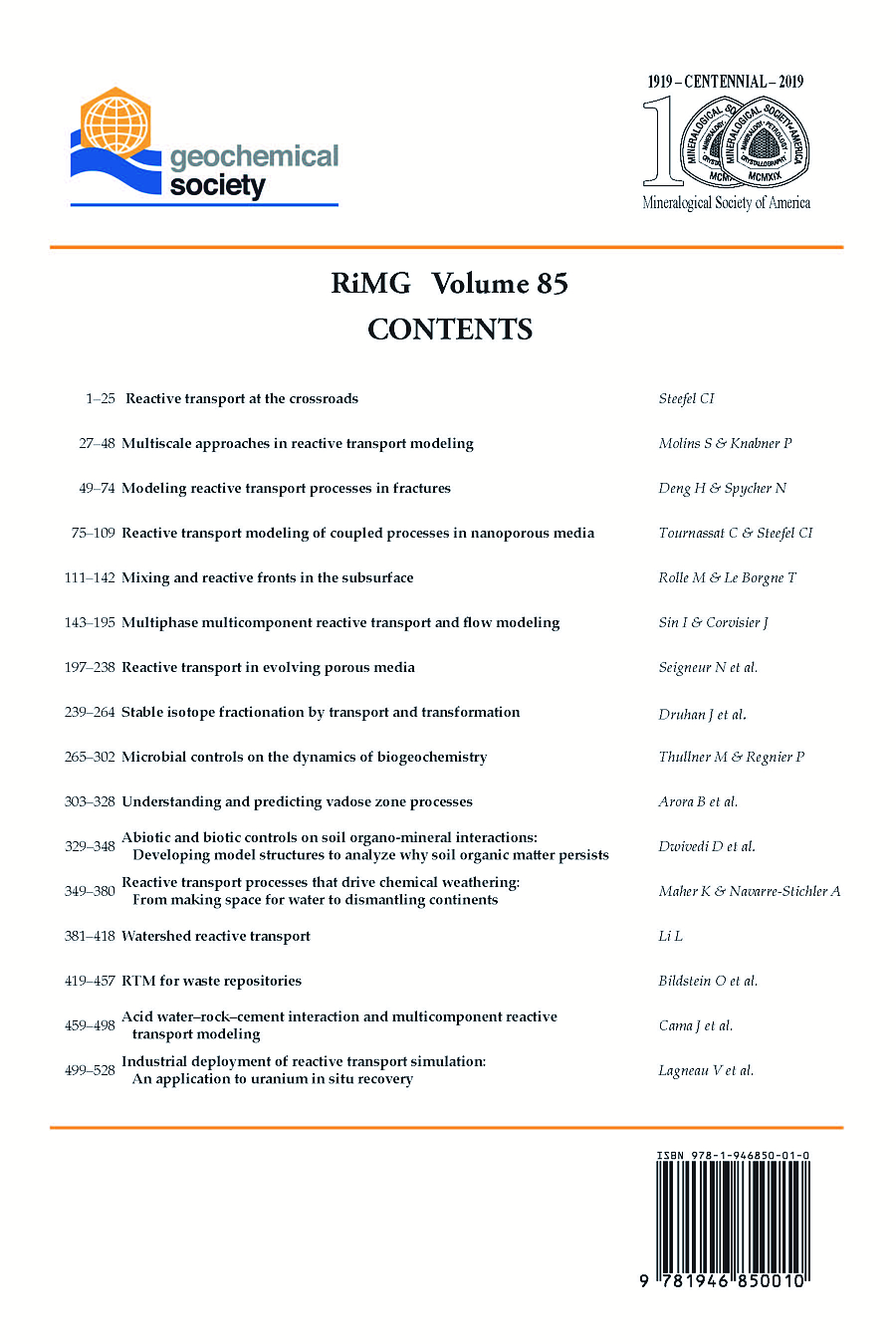

Mineralogical Society of America, Founded December 30, 1919
Subscriber Access MinPubs.org Pay-Per-View
Order Publications Online (25% discount for MSA, CMS and GS members, except shipping)


2019, i-xv + 528 pages. ISBN 978-0-946850-01-0
Open system behavior is predicated on a fundamental relationship between the timescale over which mass is transported and the timescale over which it is chemically transformed. This relationship describes the basis for the multidisciplinary field of reactive transport. In the 20 years since publication of RiMG volume 34: Reactive Transport in Porous Media, reactive transport principles have expanded beyond early applications largely based in contaminant hydrology to become broadly utilized throughout the Earth Sciences. Reactive transport is now employed to address a wide variety of natural and engineered systems across diverse spatial and temporal scales, in tandem with advances in computational capability, quantitative imaging and reactive interface characterization techniques. This breadth of application demonstrates an increasing recognition among the Earth Science community of (1) the balance between chemical reactivity and transport of (multiple) phases and (2) the coupled nature of these processes in the terrestrial environment.
The extraordinary expansion in application and diversity of reactive transport models developed over the past 20 years motivates this timely update to the 1996 RiMG volume. In the last two decades, the community has organized a series of benchmarking efforts, resulting in multiple demonstrations of confidence and reliability between independent simulation frameworks. Perhaps the most broadly utilized set of test cases, the MoMaS benchmark initiated in 2002, allows code developers and users to step through a set of sequential generalized simulations featuring increasing dimensions, reactive pathways and mobile/immobile species, culminating in a simulation that is both highly non-linear and heterogeneous. Since 2011, the Subsurface Environmental Simulation Benchmarking (SeSBench) initiative has built upon this basis to propose multiple code benchmark exercises for which the model descriptions are contextualized in natural or engineered systems of interest. In tandem with these capabilitydriven code comparisons, multiple scientific community workshops have been cultivated in the interest of expanding reactive transport principles within a given discipline. For example, a 2014 workshop held in the United States, “Expanding the Role of Reacting Transport Modeling within the Biogeochemical Sciences”, invited a variety of modeling specialists and critical zone scientists to discuss reactive transport principles, opportunities, limitations and needs. Subjects such as chemical weathering across climate gradients, the storage, cycling and stability of carbon in soils, the functioning of the rhizosphere in the development of soil, the signatures of isotope partitioning in chemically complex systems and the leveraging of omics data within biogeochemically dynamic systems were identified as critical areas standing to benefit from quantitative reactive transport frameworks. The publication resulting from this gathering has served as a guide towards future reactive transport software development as these principles are applied to an ever-expanding diversity of Earth systems. In 2017, a workshop held in France emphasized “Reactive transport in the Earth and Environmental Sciences for the 21st Century”. This gathering reviewed state of the art capabilities and future directions of reactive transport in application to Earth systems and served as the starting point for the present RiMG volume.
The progress made in such workshops has been complemented by an increasingly frequent and broad diversity of conference sessions dedicated to reactive transport modeling which now routinely reach large international audiences. Only a few months ago, Elements magazine dedicated their April 2019 issue to the subject of reactive transport modeling. These short-format articles intended for a general geoscience audience proved an ideal and timely complement to the present RiMG volume, where interested readers may alternate between accessible overviews and the extensive detail provided herein. As noted in this Elements issue, the interface between scientists and software is evolving and the so-called ‘black box’ era of model operation segregated from all but the most advanced user is coming to an end. Educational material, short courses and training programs are increasingly commonplace and broadly available. Computer literacy is closer to a native language in the next generation of Earth scientists. Most importantly the ability to leverage process in a predictive framework is now more vital than ever as we face a rapidly changing Earth system challenged with the need to sustain an increasing global population. In total, the necessity of forward computational frameworks as a platform for the mathematical representation of such complex, multicomponent, coupled and coevolving systems as soil, crops, contaminants and water is paramount to the next century of resource management and environmental sustainability.
In this review, we depart from the structure of the prior RiMG reactive transport volume, which was primarily sectioned based on modeling capabilities, in favor of scientific topics describing recent applications, techniques and current requirements necessary to foster future advances. At the widest view these chapters fall into three categories. The first set emphasize the state of reactive transport simulation capability to address challenging new frontiers such as multi-scale hybrid approaches, fractured and nanoporous media, multiphase systems, and evolving physical structures. The second set then focus on a variety of novel or expanded reactive transport applications in Earth Science such as stable isotope partitioning, microbial catalysis, vadose zone systems, soils, and watersheds. Finally, the third set emphasizes industrial applications of reactive transport modeling in the fields of waste repositories, carbon sequestration, and sub-surface resource recovery. In total this volume serves as a significant update to its predecessor, describing the diversity of applications that reactive principles are now used to quantify, and highlighting the key areas of reactive transport software development necessary to continue advancing these fields.
Title Page
p. i
Copyright
p. ii
Title
p. iii
Preface
p. iv
Table of Contents
p. vi-xv
Chapter 1. Reactive Transport at the Crossroads
by Carl I. Steefel, p. 1–26 Download (2.5 MB) 
Chapter 2. Multiscale Approaches in Reactive Transport Modeling
by Sergi Molins and Peter Knabner, p. 27–48 Download (4.1 MB) 
Chapter 3. Modeling Reactive Transport Processes in Fractures
by Hang Deng and Nicolas Spycher, p. 49–74 Download (3.5 MB) 
Chapter 4. Reactive Transport Modeling of Coupled Processes in Nanoporous Media
by Christophe Tournassat and Carl I. Steefel, p. 75–110 Download (2.6 MB) 
Errata for the print version of Chapter 4 as a pdf (Download (100 KB))
Chapter 5. Mixing and Reactive Fronts in the Subsurface
by Massimo Rolle and Tanguy Le Borgne, p. 111–142
Chapter 6. Multiphase Multicomponent Reactive Transport
and Flow Modeling
by Irina Sin and Jérôme Corvisier, p. 143–196 Download (7.4 MB) 
Chapter 7. Reactive Transport in Evolving Porous Media
by Nicolas Seigneur, K. Ulrich Mayer, and Carl I. Steefel, p. 197–238 Download (7.4 MB) 
Chapter 8. Stable Isotope Fractionation by Transport and Transformation
by Jennifer L. Druhan, Matthew J. Winnick, and Martin Thullner, p. 239-264
Chapter 9. Microbial Controls on the Biogeochemical Dynamics in the Subsurface
by Martin Thullner and Pierre Regnier, p. 265–302 Download (1.1 MB) 
Chapter 10. Understanding and Predicting Vadose Zone Processes
by Bhavna Arora, Dipankar Dwivedi, Boris Faybishenko, Raghavendra B. Jana, and Haruko M. Wainwright, p. 303–328 Download (1.1 MB) 
Chapter 11. Abiotic and Biotic Controls on Soil Organo–Mineral Interactions:
Developing Model Structures to Analyze Why Soil Organic Matter Persists by Dipankar Dwivedi, Jinyun Tang, Nicholas Bouskill, Katerina Georgiou, Stephany S. Chacon, and William J. Riley, p. 329–348 Download (948 KB) 
Chapter 12. Reactive Transport Processes that Drive Chemical Weathering: From Making Space for Water to Dismantling Continents
by Kate Maher and Alexis Navarre-Sitchler, p. 349–380
Chapter 13. Watershed Reactive Transport
by Li Li, p. 381–418 Download (3.2 MB) 
Chapter 14. RTM (Reactive Transport Modeling) for Waste Repositories
by Olivier Bildstein, Francis Claret, and Pierre Frugier, p. 419–458 Download (854 KB) 
Chapter 15. Acid Water–Rock–Cement Interaction and Multicomponent Reactive Transport Modeling
by Jordi Cama, Josep M. Soler, and Carles Ayora, p. 459–498
Chapter 16. Industrial Deployment of Reactive Transport Simulation: An Application to Uranium In situ Recovery
by Vincent Lagneau, Olivier Regnault, and Michaël Descostes, p. 499–528 Download (3.9 MB) 